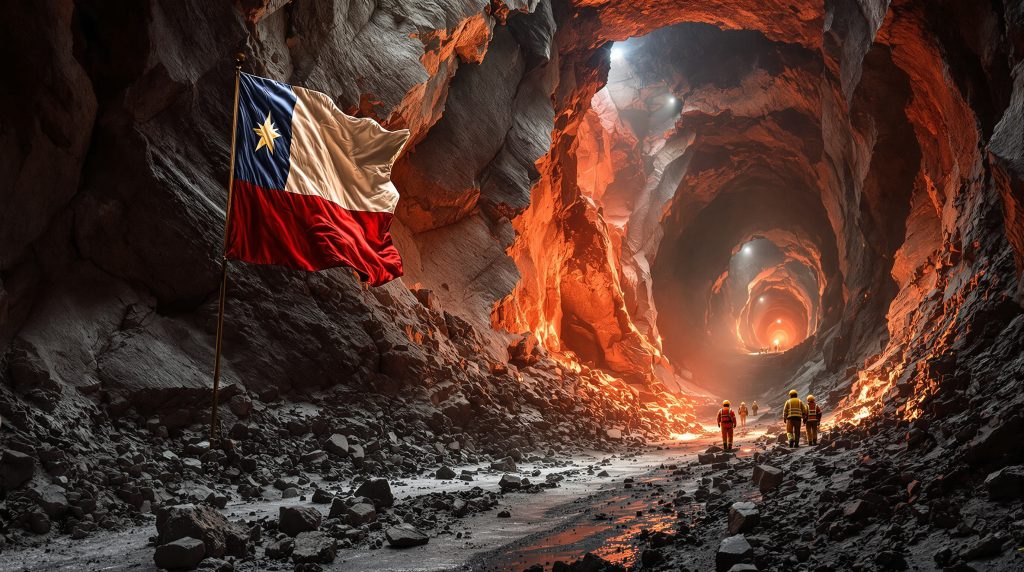Understanding the El Teniente Mine Collapse: Causes, Impact, and Safety Implications
The catastrophic collapse at Chile's El Teniente copper mine stands as a watershed moment for mining safety standards worldwide. As the industry grapples with the implications of this disaster, examining its causes, consequences, and the resulting safety improvements provides valuable insights for underground mining engineering. This comprehensive analysis explores the technical factors behind the El Teniente mine collapse and the broader implications for underground mining safety.
What Happened at El Teniente Mine in July 2025?
On July 31, 2025, at precisely 5:34 PM, the El Teniente copper mine in Chile experienced a devastating collapse following a powerful 4.3 magnitude seismic event. This earthquake far exceeded the mine's design tolerance of 1.5 magnitude, triggering a catastrophic rock burst with fatal consequences. The disaster had two main epicenters: one in the Andesita section where one worker died, and another at the seventh level in the northern part of the Teniente section where five additional miners became trapped and subsequently perished.
According to Mining Technology's reporting of the official investigation, no observable warning signs or smaller seismic movements preceded the main event, making prediction impossible. The mine's emergency protocols were activated immediately, successfully evacuating approximately 2,500 workers from the sprawling mine complex—a testament to the effectiveness of crisis management systems despite the tragic loss of life.
The El Teniente mine, operational since 1905, has produced over 80 million tonnes of fine copper during its history, making it a cornerstone of Chile's mining industry and national economy. This collapse represents the deadliest incident at the mine since the 1990 disaster that also claimed six lives.
Why Did the El Teniente Mine Collapse Occur?
The "New Phenomenon" Explanation
During his presentation at the FT Live Metals and Mining Summit on October 10, 2025, Codelco Chairman Máximo Pacheco described the collapse as "a new phenomenon" with devastating consequences. The preliminary investigation identified "a process of vertical unloading due to geometric changes and cavity interaction in the north-west of the deposit" as the most probable cause.
This technical explanation points to a complex structural failure mechanism rarely seen in modern mining operations. As Pacheco explained, the rock burst "overwhelmed" the mine's fortification systems "with tremendously painful consequences" despite adherence to standard safety protocols.
Technical Factors Contributing to the Collapse
The El Teniente collapse resulted from a perfect storm of several interconnected factors:
1. Structural Weakening Through Cavity Interaction
Over decades of continuous mining operations, the extensive network of tunnels and excavated areas gradually developed interconnected cavities throughout the deposit. These cavities weakened the overall structural integrity of the surrounding rock mass, creating conditions where localized failures could propagate into larger collapses.
2. Design Limitations Against Seismic Forces
The mine's support systems were engineered to withstand seismic events up to 1.5 magnitude—a standard that had proven adequate for decades. However, the July earthquake measured 4.3 on the Richter scale, nearly three times stronger than design specifications. On the logarithmic Richter scale, this represents approximately 1,000 times more energy than the mine's design tolerance.
3. Complex Network of Interconnected Operations
El Teniente features seven underground mines and one open-pit operation interconnected by an astonishing 4,500km of tunnels—enough to stretch from Santiago to Buenos Aires. This complex network created a labyrinth of excavated spaces where cavity connections eventually enabled the catastrophic downward movement of material that overwhelmed fortification systems.
4. Block Caving Mining Method Vulnerabilities
El Teniente primarily utilizes block caving, a highly productive mining method that involves undercutting an ore body and allowing it to collapse under its own weight. While efficient, this method creates large void spaces that can interact in unpredictable ways, especially in a mine with over a century of operations and multiple adjacent caving operations.
5. Absence of Warning Signs
Unlike some mining disasters where preliminary tremors provide warning signs, seismic monitoring records showed no observable movements before the main event. This sudden onset without precursor activity eliminated any possibility for preventative evacuation.
How Has the El Teniente Disaster Impacted Chilean Mining?
Production and Economic Consequences
The disaster has significantly disrupted operations at one of the world's largest underground copper mines, with ripple effects throughout Chile's mining sector and copper markets globally. This disruption comes at a particularly challenging time for Codelco, which has already experienced declining copper production from pre-pandemic levels of 1.7 million tons annually to approximately 1.4 million tons.
The temporary closure for investigation and implementation of safety improvements will likely further impact Chile's copper output and global supply chains. As Chile provides nearly 30% of the world's copper supply, any significant disruption at El Teniente affects global markets and prices.
National Response and Regulatory Implications
The collapse represents Chile's deadliest mining accident in decades and prompted a period of national mourning. The incident has renewed public focus on mining safety standards and regulatory oversight in a country where mining forms a critical part of the national economy and identity.
Chile's National Geology and Mining Service (Sernageomin) launched a comprehensive review of safety standards for all underground mining operations in the country, particularly focusing on operations in seismically active regions and those employing block caving mining methods.
What Safety Improvements Are Being Implemented After the Collapse?
Comprehensive Investigation and International Expertise
Codelco has initiated a thorough investigation involving international experts in rock mechanics, seismic monitoring, and modern mine planning to determine the exact causes and prevent similar tragedies. This approach mirrors the company's response to the 1990 disaster at the same mine, which also claimed six lives and led to significant safety improvements.
The investigation team includes specialists from major mining research institutions and consulting firms with expertise in underground mining safety and rock burst prevention.
Proposed Technical Improvements
Based on preliminary findings, Codelco is implementing several safety enhancements across eight critical areas:
1. Advanced Terrain Studies
- Implementation of 3D geological modelling insights to map hidden geological structures
- Enhanced laboratory testing of rock mass properties under varying stress conditions
- Integration of geological data with stress modeling for comprehensive risk assessment
2. Improved Rock Mass Preparation
- New pre-conditioning techniques to relieve rock stress before mining
- Controlled blasting patterns designed to minimize induced seismicity
- Systematic rock reinforcement in high-stress zones identified through advanced modeling
3. Enhanced Support Design
- Development of dynamic support systems capable of absorbing energy from seismic events
- Installation of yielding support elements that can deform without failing during rock bursts
- Increased support density in identified high-risk areas and intersection points
4. Mechanization Advancements
- Expanded use of remote-controlled equipment in high-risk areas
- Implementation of autonomous mining systems to reduce human exposure
- Development of teleremote technology for operating equipment from surface control rooms
5. Deep Monitoring Systems
- Installation of advanced microseismic monitoring arrays throughout the mine complex
- Real-time analysis of seismic data with automated alert systems
- Integration of multiple data sources for comprehensive ground behavior monitoring
6. Updated Numerical Models
- Development of sophisticated 3D stress models incorporating multiple mining horizons
- Dynamic simulations of rock mass behavior under varying mining sequences
- Calibration of models against observed seismic activity and deformation measurements
7. Experimental Failure Simulations
- Laboratory testing of scaled physical models to simulate potential failure mechanisms
- Computer simulations of progressive cave propagation and interaction
- Validation of support system performance under extreme loading conditions
8. Global Long-term Monitoring
- Continuous assessment of structural integrity throughout the mine
- Regular reviews of ground support performance and adaptation to changing conditions
- Integration of monitoring data into predictive maintenance systems
How Does El Teniente's History Inform Current Safety Practices?
Learning from Past Disasters
The 2025 collapse is not the first tragedy at El Teniente. In 1990, six miners were killed in a rock explosion at the same mine when Pacheco was serving as chief operating officer. That incident led to significant safety improvements, including new certification processes and microseismic monitoring technologies.
Additionally, El Teniente was the site of Chile's worst mining disaster in 1945, when the "Smoke Tragedy" caused by a fire claimed the lives of 355 miners. Each of these historical disasters has shaped safety protocols and emergency response procedures at the mine.
Evolution of Mining Safety at El Teniente
Following previous incidents, El Teniente implemented several innovations that have become standard practice in underground mining operations:
1. International Expert Consultation
- Establishment of a permanent advisory panel of international mining safety experts
- Regular external audits of safety systems and procedures
- Collaborative research programs with leading mining universities and research institutions
2. Certification Technologies
- Development of rigorous standards for tunnel integrity verification
- Systematic quality control processes for ground support installation
- Regular recertification requirements for critical infrastructure
3. Advanced Monitoring Systems
- Implementation of distributed fiber optic sensing for detecting ground movement
- Integration of atmospheric monitoring with ventilation control systems
- Development of personnel tracking systems for rapid accountability during emergencies
4. Remote Operation Capabilities
- Progressive automation of high-risk mining activities
- Establishment of surface control centers for remote equipment operation
- Development of teleremote systems for operating machinery from safe locations
What Makes Underground Mining at El Teniente Particularly Challenging?
Unique Geological Conditions
El Teniente presents exceptional challenges due to its size, complexity, and geological setting. As the world's largest underground copper mine, it features several distinctive characteristics:
1. Extensive Tunnel Network
- 4,500km of interconnected tunnels create complex structural interactions
- Multiple mining levels operating simultaneously across different elevations
- Centuries of historical workings creating a complex three-dimensional network
2. Multiple Mining Areas
- Seven underground mines and one open-pit operation create a labyrinth of excavated spaces
- Different mining methods employed in various sectors based on local conditions
- Interconnected ventilation and transport systems spanning multiple operations
3. Deep Operations
- Mining at significant depths increases geologic pressure and seismic risk
- High in-situ stress conditions create potential for violent rock failures
- Temperature and ventilation challenges requiring sophisticated air conditioning systems
4. Evolving Cavity Structures
- As mining progresses, new cavities form and connect with existing ones
- Unpredictable stress patterns develop as multiple caves interact
- Dynamic conditions that change as extraction continues in adjacent areas
Inherent Risks of Underground Mining
Rock bursts represent an inherent danger in deep mining operations, particularly in hard rock environments like El Teniente. These sudden, violent failures of rock occur when stress exceeds rock strength, often triggered by seismic events. While they cannot be eliminated entirely, improved monitoring and support systems can reduce their frequency and impact.
The risk factors at El Teniente include:
- High Stress Concentration: Deep mining creates high stress concentrations at extraction boundaries
- Geological Discontinuities: Faults and joints provide potential failure planes
- Mining-Induced Seismicity: Excavation activities can trigger localized seismic events
- Regional Tectonic Setting: Chile's location on the Pacific Ring of Fire creates background seismic activity
What Are the Broader Implications for Global Mining Safety?
Setting New Industry Standards
The El Teniente disaster and subsequent investigation will likely influence mining safety practices globally, particularly for deep underground operations in seismically active regions. The findings could lead to revised international standards for mine design, monitoring systems, and emergency protocols.
Industry organizations such as the International Council on Mining and Metals (ICMM) are likely to incorporate lessons from El Teniente into their safety guidelines, creating a ripple effect throughout global mining operations.
Balancing Production and Safety
The incident highlights the ongoing challenge of balancing production demands with worker safety. As mines go deeper and extract more challenging deposits, the industry must continue developing more sophisticated safety systems and predictive capabilities.
Several key considerations have emerged:
- Economic Pressures: The need to maintain production while implementing costly safety improvements
- Technological Solutions: Increased investment in automation and remote operations
- Regulatory Evolution: Potential strengthening of safety regulations in major mining jurisdictions
- Risk Assessment Methods: Development of more sophisticated approaches to quantifying and mitigating risk
Future of Underground Mining
The disaster may accelerate the adoption of automation and remote operation technologies that reduce human exposure to high-risk areas. These technologies, already part of El Teniente's "intelligent mining" approach, could become industry standard for similar operations worldwide.
Key technological trends likely to accelerate include:
- Autonomous Mining Equipment: Self-operating loaders, trucks, and drilling equipment
- Remote Control Centers: Surface-based operations centers controlling underground equipment
- Advanced Sensing Technologies: Distributed monitoring systems providing real-time data
- Artificial Intelligence Applications: Predictive analytics for ground stability assessment
What Questions Remain About the El Teniente Collapse?
Ongoing Investigation Priorities
Several critical questions remain as the investigation continues:
1. Monitoring System Adequacy
- Could improved or different monitoring technologies have detected warning signs?
- Were there subtle precursors that existing systems couldn't detect?
- How can monitoring sensitivity be balanced against false alarm prevention?
2. Structural Assessment Challenges
- Were there overlooked structural weaknesses in the affected areas?
- How can cavity connections be better identified before they become problematic?
- What inspection technologies might reveal hidden deterioration?
3. Design Methodology Revisions
- How can mine design better account for interconnected cavity effects?
- What safety factors should be applied to seismic design criteria?
- How should historical workings be incorporated into current stability analyses?
4. Historical Mining Impacts
- What role did historical mining practices play in creating conditions for collapse?
- How can legacy risks from older sections be better evaluated?
- What remediation strategies might address historical voids?
5. Seismic Design Standards
- Are current seismic design standards adequate for modern deep mining operations?
- How should regional seismic risk be incorporated into mine-specific design criteria?
- What monitoring thresholds should trigger operational changes?
Long-term Safety Assurance
The ultimate question is whether El Teniente and similar mines can implement systems that truly prevent such tragedies in the future, or if certain inherent risks will always remain in deep underground mining operations.
The balance between technological solutions, operational practices, and acceptable risk levels remains a central challenge for the industry. While automation and improved data-driven mining operations can reduce risk, the fundamental challenges of extracting ore from deep, high-stress environments will continue to present significant safety challenges.
FAQs About the El Teniente Mine Collapse
What is El Teniente mine?
El Teniente is the world's largest underground copper mine, located near Rancagua, Chile, approximately 80 kilometers south of Santiago. It features seven underground mines and one open-pit operation interconnected by 4,500km of tunnels and has been in continuous operation since 1905.
How many miners died in the 2025 El Teniente collapse?
Six miners died in the collapse: one in the Andesita section and five others who were trapped in the northern part of the Teniente section at the seventh level.
What caused the 2025 El Teniente mine collapse?
The collapse was caused by a 4.3 magnitude seismic event that triggered a rock burst. The preliminary investigation identified "vertical unloading due to geometric changes and cavity interaction" as the most probable cause, where interconnected cavities developed throughout the mine's extensive tunnel network weakened the overall structure.
Has El Teniente experienced similar disasters before?
Yes. In 1990, six miners were killed in a rock explosion at El Teniente when current chairman Máximo Pacheco was serving as chief operating officer. The mine was also the site of Chile's worst mining disaster in 1945, when 355 miners died in the "Smoke Tragedy" caused by a fire.
What safety improvements is Codelco implementing after the collapse?
Codelco is implementing deeper terrain studies, new rock mass preparation techniques, improved support design, mechanization, enhanced monitoring systems, updated numerical models, experimental failure simulations, and a global long-term monitoring plan. These improvements aim to address the specific factors that contributed to the 2025 disaster.
Further Exploration:
Readers interested in learning more about mining safety and the El Teniente mine can also explore related educational content about industry evolution trends, which offers additional perspectives on mining operations and safety challenges in Chile's copper industry. The evolving nature of deep underground mining technology and safety systems continues to be a critical area of focus for mining companies and regulatory authorities worldwide.
Want to Spot the Next Major Mining Discovery Before the Market Does?
Discover why major mineral discoveries like El Teniente create substantial investment returns by exploring Discovery Alert's dedicated discoveries page, where their proprietary Discovery IQ model delivers real-time alerts on significant ASX mineral discoveries, instantly empowering subscribers to identify actionable opportunities ahead of the broader market.




